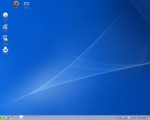openSUSE 10.2 RC 1 Report



 We're in the homestretch now. The only planned release candidate of openSUSE 10.2 was released a few days ago and final is expected to be released to the public on December 7. From this point on only showstopper and security bugfixes get integrated, so we are able to get a real good idea of 10.2 from this rc. I must say, from what I've seen, this is going to be a great release.
We're in the homestretch now. The only planned release candidate of openSUSE 10.2 was released a few days ago and final is expected to be released to the public on December 7. From this point on only showstopper and security bugfixes get integrated, so we are able to get a real good idea of 10.2 from this rc. I must say, from what I've seen, this is going to be a great release.
This time around I thought it might be fun to test the upgrade procedure. Granted it was only from beta 2 to rc 1, but it went without a hitch (unless the few app glitches were due to the upgrade). With the system resulting from an upgrade, all hardware was already configured and as such, everything worked. This enabled the internet test and the downloading of release notes as well as the online update configuration to be successful. As stated in the changelog, ext3 is now the default filesystem.
The update process is much more simplified than a fresh install, only requiring a fraction of the steps. This time the selection splash screen presented at first boot of the install DVD was the old Pingus modification. I'd forgotten all about that one, but I guess it's fitting for the time of year. I booted the install disk several times, and it appeared each time. I gotta say, I think I prefer animated penguins in santa caps to the big lizard photo. The next busy splash is a bit updated from our last report, as are all the splash screens. There isn't a big change, but the ends of the wisps seem to diverge or flare out a bit more. The color scheme has remained the same.
Once at the desktop we finally see a new openSUSE wallpaper. As suspected, it does indeed match the new splash screens. It's not an exact copy and may not be the final incarnation, but at this point it's a non-distracting background with just a hint of pattern on top of the blue foundation. It's very typical of default wallpapers found in both KDE and openSUSE.
As this is the release candidate that incorporated only serious bug fixes and last minute documentation, we didn't find any surprises. Actually, that may not be exactly so. I was quite suprised at the performance increase experienced this release. I suppose it could be contributed to disabling verbose bug reporting, but it's quite noticeable. For example, OpenOffice.org opened too fast to catch a screenshot of its splash screen.
I did experience a couple of glitches with the apps. The first one was banshee would not open. It bailed out at the splash screen. Another problematic application was gnucash. Again, it just wouldn't open only giving a quick glimpse of the splash before its crash and burn. Everything else seemed to function well in the minimal testing received here. Both KDE and Gnome seemed to behave really well too. The software managers worked as designed as far as could be tested (by installing and uninstalling a few packages). We did experience some difficulty when trying to install iceWM due to conflicting files.






Andreas Jaeger said of this release, "The areas that we had to work hardest on were the bootloader configuration and our software management stack."
He further explains, "For our software management stack we now have two different user interfaces: The ZENworks Linux interface introduced in SUSE Linux 10.1 with the commands rug and zen-updater - and the new software management tools zypper and opensuse-updater. Zypper accepts most of the commands that rug does with the same syntax. The applet opensuse-updater can talk to the zmd daemon or use directly the package management library without a running daemon. During installation the ZENworks tools are installed by default with the "Enterprise Software Management (ZENworks Linux Management)" pattern, the other one is name "openSUSE Software Management" and can be used alternatively."
RPM Highlights:
- kernel-default-2.6.18.2-23
- xorg-x11-7.2-23
- gcc-4.1.3-28
- kdebase3-3.5.5-63
- gnome-desktop-2.16.1-25
- qt3-3.3.7-11
- libqt4-4.2.1-17
- gtk2-2.10.6-12
- OpenOffice_org-2.0.4-35
- MozillaFirefox-2.0-19
- gimp-2.2.13-26
- amarok-1.4.4-27
- blender-2.42a-23
- gaim-1.5.0-84
- dbus-1-1.0.0-6
- Full RPMList
Changelog Highlights:
++++ release-notes:
- 10.2.9:
* New Default File System: ext3. .
++++ gnome-main-menu:
- Use package-manager instead of zen-updater.
- Dropped recommends: zen-updater.
++++ compiz:
- Patch gnome-xgl-settings to use the new package-manager
abstraction.
++++ kdebase3-SuSE:
- don't start greeter on every login
- update splash screen preview picture
- invalidate splash screen cache to ensure new one gets shown
- update of splash screen artwork for 10.2
- trigger the kmenu when the greeter closes to avoid focus handling
locks
++++ sax2:
- sometimes usb mice were missed
++++ qtcurve-gtk2:
- fix gtk-window-decorator crash
++++ xorg-x11-driver-video:
- updated (optional) intel modesetting driver (git_2006-11-21)
* Enable second SDVO channel. Rework SDVO support so that it
can deal with two channels correctly, also save/restore all
connected output timings.
* Set configured values for screen virtual size and initial
frame. Computation for virtual size and initial frame origin
is quite broken in xf86 common code.
++++ yast2-printer:
- remote printers are allowed to modify
++++ OpenOffice_org:
- updated ooo-build to version 2.0.4.7:
* wrong calculation in Calc, r1c1 stuff
* searching for JREs
++++ evolution:
- update to version 2.8.2
- translation updates
++++ f-spot:
- Fix picasa web export.
++++ openSUSE-release:
- Not anymore beta...
++++ suseRegister:
- fix parameter List when --no-hw-data is given
++++ planmaker:
- Update to latest version from Softmaker
++++ xcdroast:
- fix dvd burning
++++ yast2-scanner:
- V 2.14.9
- Fixed creation of interface_and_usbid_string in the model_items
list (set interface_and_usbid_string to the empty string if
the scanner has neither SCSI nor USB).
- Using better syntax for the model preselection code
(regarding access integer values in term types).
++++ cups:
- Upgrade to 1.2.7 (another bugfix version)
++++ Full Changelog
Most Annoying Bugs:
- opensuseupdater opens its window on every desktop login. fix, as root: 'echo "NotShowIn=KDE;" >>/opt/kde3/share/autostart/opensuseupdater.desktop'
- grub crashes with default proposal & dmraid
Release Notes Highlights:
- Switch from Firefox version 1.5 to version 2 is a major update. Some themes and extensions will not work anymore. Default keybindings are changed.
- The "cdrecord" package has been dropped from the distribution. The new "wodim" package can be used.
- The update of CUPS from version 1.1 to 1.2 carries incompatible changes. It is not possible to convert the printer configuration from the previous CUPS versions automatically.
- Experts can now rely on YaST for configuring LVM (Logical Volume Manager) and EVMS (Enterprise Volume Management).
- The X.Org system is installed in /usr. Adjust your programs if needed.
- The suspend framework switched from powersaved to pm-utils.
- Full Release Notes
As you can see things seem to be shaping up quite nicely. The Most Annoying Bug list consists of only two items. The changelog contained many bug fixes and also a few version upgrades. The Release Notes are practically complete for the 10.2 release. System operations are becoming more refined with only minimal problems and the glitches of previous final release are just about massaged out of the new software manager. The system itself is looking very slick as well. It appears we are in for a great release this time. No matter your stance on the political issues with Novell lately, the efforts of the openSUSE developers are very apparent and are worthy of note. I find this release candidate looking great and functioning even better. I'm very much looking forward to the final due in just about two weeks. We at Tuxmachines plan on reporting our experiences upgrading from 10.1 as well as a fresh install.

-

- Login or register to post comments
 Printer-friendly version
Printer-friendly version- 114563 reads
 PDF version
PDF version
More in Tux Machines
- Highlights
- Front Page
- Latest Headlines
- Archive
- Recent comments
- All-Time Popular Stories
- Hot Topics
- New Members
digiKam 7.7.0 is released
After three months of active maintenance and another bug triage, the digiKam team is proud to present version 7.7.0 of its open source digital photo manager. See below the list of most important features coming with this release.
|
Dilution and Misuse of the "Linux" Brand
|
Samsung, Red Hat to Work on Linux Drivers for Future Tech
The metaverse is expected to uproot system design as we know it, and Samsung is one of many hardware vendors re-imagining data center infrastructure in preparation for a parallel 3D world.
Samsung is working on new memory technologies that provide faster bandwidth inside hardware for data to travel between CPUs, storage and other computing resources. The company also announced it was partnering with Red Hat to ensure these technologies have Linux compatibility.
|
today's howtos
|









.svg_.png)
 Content (where original) is available under CC-BY-SA, copyrighted by original author/s.
Content (where original) is available under CC-BY-SA, copyrighted by original author/s.

Recent comments
1 year 11 weeks ago
1 year 11 weeks ago
1 year 11 weeks ago
1 year 11 weeks ago
1 year 11 weeks ago
1 year 11 weeks ago
1 year 11 weeks ago
1 year 11 weeks ago
1 year 11 weeks ago
1 year 11 weeks ago